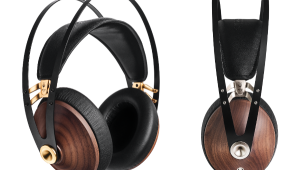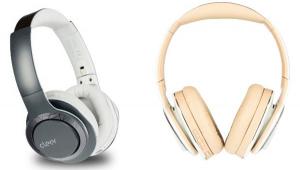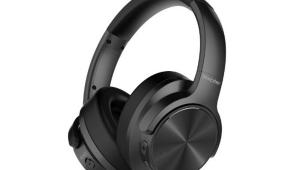Review: Rock-It R-30 Headphones

There must be hundreds of brands and thousands of models of in-ear monitors (IEMs) now, and probably 95 percent of them are as generic as 2x4s. But it's obvious that a lot of thought went into the Rock-It R-30.
Like most IEMs, the R-30 comes with three sizes of ear tips, but it also comes with three blobulous silicone gel things that slip around the earpieces so they fill your ears better. The idea is that you get a semi-custom fit, kinda halfway to a custom-molded IEM. The little "legs" extending from the silicone blobs make the earpieces look like plucked chickens. Fortunately, no one will notice when they're in your ears.
The clashing aesthetics of the R-30's two-tone cables and mango-colored earpieces let the superficial, Beats-worshipping masses know that you don't give a damn what your headphones look like. Beware, though, because those attention-getting cables snarl as easily as a fishing rod in the hands of a four-year-old.
I'm saving the best for last: the R-30 is a balanced armature headphone for just $69! Most IEMs use standard dynamic drivers that are basically miniaturized versions of the drivers in an ordinary speaker. A balanced armature is like a little teeter-totter suspended in a magnetic field; one end of the teeter-totter drives a diaphragm that produces sound. Balanced armatures are known for delicate, detailed treble but often somewhat weak bass - so they tend to be great for audiophiles but not necessarily so great for the average listener. Most single balanced armature IEMs cost $100 and up.
Rock-It headphones are sold online only, and there's a 30-day money-back guarantee if you don't like them.
Chicken, duck, or turkey?
To get a balanced impression of the R-30's sound, I listened for a couple of weeks myself then called in frequent S+V headphone panelist Lauren Dragan, an L.A.-based voice actress who spends a lot of her life wearing headphones.
After some experimenting with the different ear tips and silicone gel blobs, I was able to get a super-comfortable yet tight-sealing fit with the R-30. It reminded me of the great fit I got from Phonak Audéo IEMs; it wasn't quite as secure in my ears, but it was even more comfortable. I wore the R-30 for a trip on Los Angeles Metro to check out the new Expo Line, using the smallest of the silicone chickens and the largest of the ear tips, and even after three hours the R-30 still felt like part of my ears rather than something I was stuffing into them.
Lauren wasn't so lucky. "I tried every combination of the ear tips and the turkey/chicken/duck things, but none of them fit my ears comfortably," she complained.
Works with iPhone … but not Droid
The sound of the R-30 depends very much on what you connect it to. As you can see in the measurements later in this review, the R-30 has a large impedance shift (a common characteristic of most single balanced-armature models) that substantially changes the tonal balance when the headphone is driven by a high-impedance source. Thus, it sounds fantastic when driven by the 1-ohm output impedance of my iPod touch, but not so good driven by the 75-ohm output impedance of my Motorola Droid Pro. With the Droid Pro, the bass output is substantially reduced and a treble peak appears at 2 kHz, which makes voices sound a little edgy.
That said, the R-30 does conform to the stereotype of balanced-armature IEMs. The treble is unusually extended and clear; on the flipside, the bass is less than powerful even when driven by a high-quality source. Even though Lauren used the R-30 with her iPhone (like the iPod touch, it's blessed with a low output impedance), she couldn't get enough bass to get a satisfying sound of the R-30. She attributed the problem to the fit, but I think it's just the nature of the beast (the R-30, not Lauren).
If I were the marketing guy at Rock-It, I'd demo the R-30 with Hawaiian slack-key guitarist Rev. Dennis Kamakahi's "Koke'e" (from Pua'ena). The R-30 sounds gorgeous on this, delivering a huge, reverberant sound on the voice yet keeping the voice solidly centered. Kamakahi's gorgeous baritone sounds full, but never bloated. Every subtle intricacy of his guitar picking is clearly audible, and the R-30 has plenty enough bass to reproduce the detuned lower strings of his guitar. It even sounded good with the Droid as a source, but the 2 kHz treble boost made Kamakahi's vocal start to sound a little edgy in places.
The Cult's "Wild Flower" (from Electric) is an example of what I wouldn't play to demo the R-30. Driven from the iPod touch, it's great - probably not as kick-ass as a serious metalhead would like, but the guitars sound colossal and ambient, the bass is tight, and Ian Astbury's vocal sounds smooth. But play the same tune from the Droid, and the bass guitar sounds more like a tenor uke while the kick drum sounds more like the top of a Quaker Oats box.
George Benson's "Giblet Gravy" (from the groovily titled and even more groovily designed CD of the same name) perfectly highlighted the difference. In this early and largely unknown era of Benson's career, he was known for hard-grooving tunes, but you wouldn't know it hearing "Giblet Gravy" through the R-30 when sourced from the Droid. All you hear from the bass is the upper harmonics. Yet you hear every subtle detail in the horns, rhythm guitar, cymbals, snare and tambourine, and most important, in Benson's kick-ass solo. Plug into the iPod Touch instead, and you get all that good stuff in the mids and highs plus reasonably grooving bass.
Measurements
I measured the R-30 using a G.R.A.S. Type RA0045 ear simulator, a Clio FW audio analyzer, and a Musical Fidelity V-Can headphone amplifier. I used supplied medium-sized silicone tips, which fit the ear simulator best. I inserted and reinserted each model several times, and settled on a position for each that gave the most representative result. Note that this didn't give me the advantage of the ear-filling silicone gels, but it's consistent with the way I measure other IEMs (I've found that results I get using the full Type 43AG ear/cheek simulator with IEMs are inconsistent, too dependent on fit with the sim's fake rubber ear.)
The frequency response measurement (measured with the V-Can's 5-ohm output impedance) indicates a prominent midrange. Unlike most headphones, which tend to have a dip in the midrange, the R-30 measures almost flat from 50 Hz to 2 kHz. There's a little extra peak at 4 kHz but otherwise it's mostly a smooth roll-off above 2 kHz..
Impedance sweeps up from a low of 12 ohms in the bass, to an average of 28 ohms (Rock-It's published rating) in the midrange to a high of 110 ohms at 20 kHz. Because of the changing impedance, adding 70 ohms output impedance to the V-Can's 5-ohm output impedance to simulate the effects of using a low-quality headphone amp does affect the frequency response, knocking bass down by about -3 dB and introducing a +2 dB treble peak at 2 kHz.
Total harmonic distortion (THD) at 100 dBA is so low it's not even worth discussing.
You may notice from the chart that I've recently changed the way I measure isolation, in order to better conform to practices recommended in IEC 60268-7, and to provide a stimulus closer to that of actual environmental noise. The R-30's isolation is excellent, especially at low frequencies. Above 100 Hz, it ranges from -15 to -33 dB. And this is without the advantage of the silicone blobs filling your ears, so your results will probably be better.
Sensitivity measured with a 1 mW signal (at the rated 28 ohms impedance) is high at 109.4 dB average from 300 Hz to 10 kHz, 112.6 dB average from 300 Hz to 6 kHz.
Bottom Line
If you have an iPhone or an iPod touch, the R-30 is easily one of today's best buys in an audiophile-grade IEM. For me, at least, the semi-custom fit thing works wonders - and if it doesn't work for you, you can always return the R-30 and get your money back. If you use a Droid for mobile listening, I have a harder time recommending the R-30, unless you combine it with a mini headphone amp. Likewise, if you use a laptop computer as your source, get a mini amp or something like the $39 HiFiMan HM-101 USB headphone amp. And if you really want big bass, skip the R-30 entirely.
That sure sounds like a lot of "ifs" - but make no mistake, the R-30 is a great product for those who want top-quality, natural-sounding audio and who are willing to exercise a little care in source device selection.
- Log in or register to post comments




































































